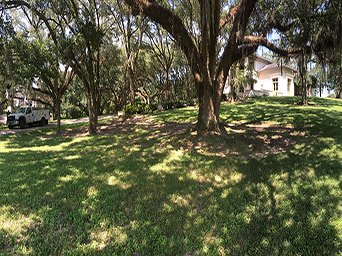
Where we live inclimate weather is just a fact of life. I mean, we are so use to bad weather, we even throw parties while the worst storms are brewing. Come on Louisiana knows how to do storms, but do we know how to do our trees? It would really be a pretty big party foul to have a tree come crashing down into your home right in the middle of an epic Hurricane Party! So let’s talk storm prep.
It sounds simple, but the first step should be to consult an educated, licensed, and insured arborist and get on a yearly tree maintenance program. Arborists are trained to recognize defects in your trees that may become a problem during severe weather. They can also trim your trees to make sure that the branches are stable and can handle the heavy winds that come with most of our famous Louisiana storms. On top of this, arborists may recommend things to keep your trees and you safe during storms like lightening protection or tree fertilization. We know our trees and we know when something looks off, but arborists are trained to see more than what our laymen eyes can see, therefore reach out to an arborist and get on a tree maintenance program.
I have spoken about this before, but proper tree mulching is another thing we as home owners can do to insure that our trees are properly cared for so they will hold up to our severe storms better. Remember no volcano mulching! Mulch should not be placed up on the trunk, it should not be spread more than three to 4 inches in thickness, and it should be spread out at least 3 feet in diameter around the tree. Get out there and mulch your trees, it is aesthetically pleasing but it is also an aid to keeping your trees healthier in order to weather the storms better.
Lastly, LOOK UP, LOOK DOWN, and LOOK AROUND. This cute little statement is just a little reminder for you home owners on what to do to inspect your own trees. First LOOK UP, this means to look into the crown, top portion of your tree, to see if you see any hazardous hanging limbs or branches. During a storm, these branches can come lose and fall on your home, fences, cars and even another person. So if you see any hangers in your tree, call an arborist to have them removed immediately.
Next, LOOK AROUND your trees. This means to take the time to walk around the circumference of each of your trees. While doing this, you should be looking for any odd cavities, cracks or deformities. You should also be look for fungal growth, like mushrooms. All of these things could show signs of decline or decay in your tree. So if you see something off, then contact an arborist to come take a more educated look. An arborist is trained to know wether you have a mild, medium or severe problem that could create issues for you during storms.
Finally, LOOK DOWN. Take the time to walk around your trees and inspect them at the base, the area where your tree’s trunk meets the ground. Again you should look for fungal growth, but also things like little white wings that may mean you have termites in your trees. Next look at the flare of the bottom of your trunk. If your trunk doesn’t have flare, then you might have an issue! The flare at the bottom of the trunk is a critical part of the tree where the trunk tissue changes into root tissue. If this area is covered with soil it can lead to tissue breakdown and other serious problems. So consult an arborist if you see fungal issues, if you see little white wings ,and if your tree just doesn’t look like it has flare.
It sounds like a lot, and but safety should always be your top concern. I mean who wants to ruin their Hurricane Party with a limb down or a tree failure. So consult an arborist and get on a yearly tree maintenance program. That way you put the trees in the hands of those who are educated to insure your trees will not be the reason your party comes to a halt!
“Healthy trees make healthier people!”
Bofinger’s Tree Service Mission Statement:
We believe in safe, superior service and strengthening client relationships through honesty, education, and awareness that trees play a vital part in our community while promoting a greener environment.







